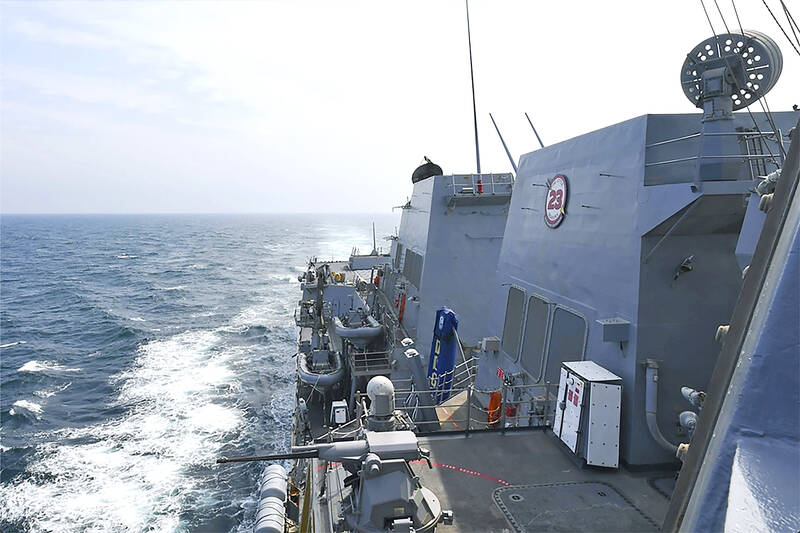The military was fully aware of an operation by the US Navy on Wednesday that involved the passage of a warship through the Taiwan Strait, the Ministry of National Defense said on Wednesday.
The US Navy’s 7th Fleet in a statement on Wednesday said that the USS Halsey “conducted a routine Taiwan Strait transit on May 8 through waters where high-seas freedoms of navigation and overflight apply in accordance with international law.”
The Arleigh Burke-class guided-missile destroyer transited through a corridor in the Strait that is “beyond the territorial sea” of any coastal state, the statement said.

Photo: US Navy via AP
“Halsey’s transit through the Taiwan Strait demonstrates the United States’ commitment to upholding freedom of navigation for all nations as a principle,” it said. “No member of the international community should be intimidated or coerced into giving up their rights and freedoms. The United States military flies, sails and operates anywhere international law allows.”
A ministry statement said that the warship entered the Taiwan Strait from the north at 7am on Wednesday, traveling southward.
The Taiwanese military was closely monitoring the surrounding sea and airspace throughout the transit, and the situation remained normal, it said.
Beijing criticized the US ship’s transit, with Chinese Navy Senior Captain Li Xi (李熹), spokesman for the Eastern Theater Command, accusing Washington of “publicly hyping” the passage.
The Eastern Theater Command “organized naval and air forces to monitor” the US ship’s transit and handle matters ”in accordance with laws and regulations,” Li said in a statement late on Wednesday.
The last such passage was on April 17, a day after US and Chinese defense chiefs held their first talks since November 2022 in an effort to reduce regional tensions.
In the 24 hours leading up to 6am yesterday, 23 Chinese military aircraft and eight naval ships were detected operating around Taiwan, the defense ministry said.
Eight of the planes crossed the median line in the Strait and entered Taiwan’s air defense identification zone, prompting Taiwan to scramble jets and put coastal missile batteries and naval craft on alert, it said.
Meanwhile, US Secretary of Commerce Gina Raimondo on Wednesday said a Chinese invasion of Taiwan and seizure of chips producer Taiwan Semiconductor Manufacturing Co (TSMC, 台積電) would be “absolutely devastating” to the US economy.
Asked at a US House of Representatives hearing about the impact, Raimondo said: “It would be absolutely devastating,” declining to comment on how or if it would happen.
“Right now, the United States buys 92 percent of its leading-edge chips from TSMC in Taiwan,” she said.
TSMC declined to comment.
A US government paper last year estimated that a major manufacturing disruption in Taiwan could lead to as high as a 59 percent increase in the US price of logic chips that domestic downstream producers would have to pay.

STILL COMMITTED: The US opposes any forced change to the ‘status quo’ in the Strait, but also does not seek conflict, US Secretary of State Marco Rubio said US President Donald Trump’s administration released US$5.3 billion in previously frozen foreign aid, including US$870 million in security exemptions for programs in Taiwan, a list of exemptions reviewed by Reuters showed. Trump ordered a 90-day pause on foreign aid shortly after taking office on Jan. 20, halting funding for everything from programs that fight starvation and deadly diseases to providing shelters for millions of displaced people across the globe. US Secretary of State Marco Rubio, who has said that all foreign assistance must align with Trump’s “America First” priorities, issued waivers late last month on military aid to Israel and Egypt, the

France’s nuclear-powered aircraft carrier and accompanying warships were in the Philippines yesterday after holding combat drills with Philippine forces in the disputed South China Sea in a show of firepower that would likely antagonize China. The Charles de Gaulle on Friday docked at Subic Bay, a former US naval base northwest of Manila, for a break after more than two months of deployment in the Indo-Pacific region. The French carrier engaged with security allies for contingency readiness and to promote regional security, including with Philippine forces, navy ships and fighter jets. They held anti-submarine warfare drills and aerial combat training on Friday in

COMBAT READINESS: The military is reviewing weaponry, personnel resources, and mobilization and recovery forces to adjust defense strategies, the defense minister said The military has released a photograph of Minister of National Defense Wellington Koo (顧立雄) appearing to sit beside a US general during the annual Han Kuang military exercises on Friday last week in a historic first. In the photo, Koo, who was presiding over the drills with high-level officers, appears to be sitting next to US Marine Corps Major General Jay Bargeron, the director of strategic planning and policy of the US Indo-Pacific Command, although only Bargeron’s name tag is visible in the seat as “J5 Maj General.” It is the first time the military has released a photo of an active

CHANGE OF MIND: The Chinese crew at first showed a willingness to cooperate, but later regretted that when the ship arrived at the port and refused to enter Togolese Republic-registered Chinese freighter Hong Tai (宏泰號) and its crew have been detained on suspicion of deliberately damaging a submarine cable connecting Taiwan proper and Penghu County, the Coast Guard Administration said in a statement yesterday. The case would be subject to a “national security-level investigation” by the Tainan District Prosecutors’ Office, it added. The administration said that it had been monitoring the ship since 7:10pm on Saturday when it appeared to be loitering in waters about 6 nautical miles (11km) northwest of Tainan’s Chiang Chun Fishing Port, adding that the ship’s location was about 0.5 nautical miles north of the No.